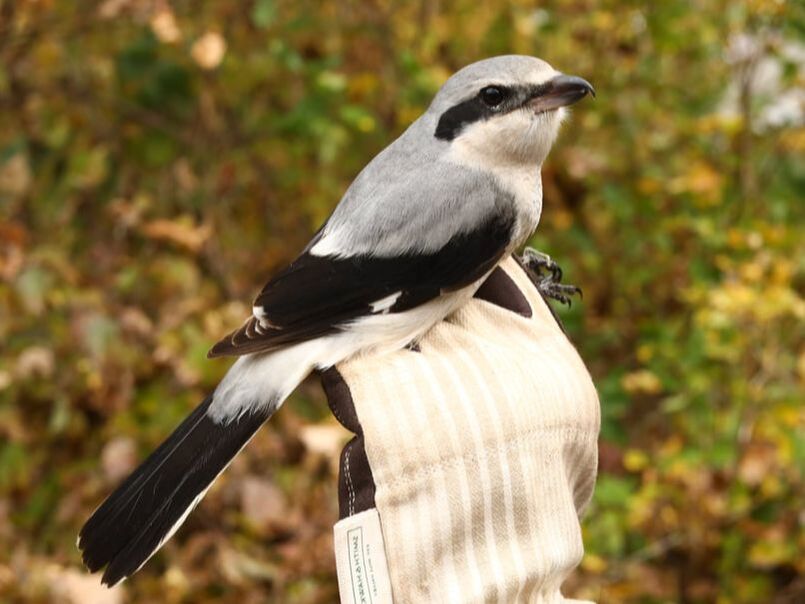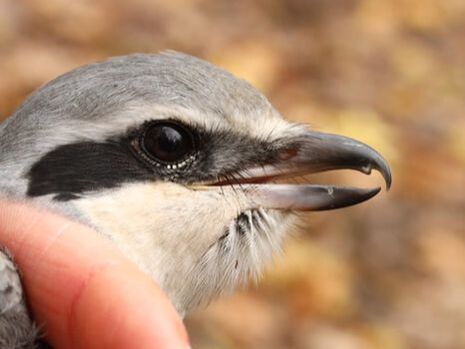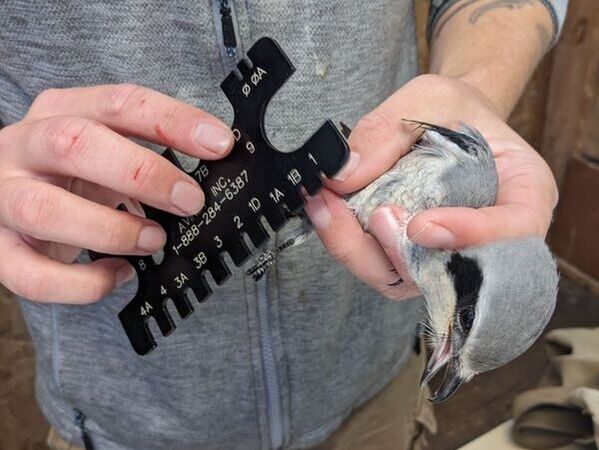Enjoying our blogs?Your support helps BSBO continue to develop and deliver educational content throughout the year.
|
|
As we looked at the forecast in preparation to wrap up our fall banding season, Saturday, November 4th, looked like it would be the perfect day to close: warm, the lightest of breezes, and sunny skies to ensure that we were putting away dry nets. But, when Saturday morning came around, we woke up to clouds and drizzle. It mostly stopped sprinkling…and then it started again…and then it stopped again. The rain was light and intermittent enough that we still opened the nets to see what we could get, but it definitely wasn’t the day that we had hoped for. “This is awful,” we moaned. “All we wanted was one American Tree Sparrow to really make it feel like winter and the end of the season.” Well, we never did catch a tree sparrow, but…we caught a NORTHERN SHRIKE!!! Only the second Northern Shrike ever caught at the station (the other one was caught in 2007), this is a bird that really deserves the capital letters and all the exclamation points. Although there are 33 shrike species worldwide, only two of them reside in North America: Loggerhead Shrike (LOSH) and Northern Shrike (NSHR). The two look very similar, but, along with other subtle plumage differences, NSHR has a narrower black mask that usually doesn’t cover the top of the eye or the top of the bill, unlike the wider mask of the LOSH. While LOSH breed in the southern United States, NSHR breed in the Arctic and only come down to the upper U.S. over the winter, so it’s not super common to see them. But, boy, are we glad this one came to visit! Having only seen shrikes from a distance before, we were surprised by how large they actually are, about the size of a robin. They’ve also got rather chunky heads, sort of reminiscent of a parrot, although they’re more closely related to ravens and crows. And, as some of us can now personally attest to, they’ve got very sharp beaks! Like falcons and hawks, shrikes have a special feature on their beaks: a projection known as a tomial tooth that aids them in capturing and killing their prey. Seems a little vicious for a songbird, right? Except shrikes aren’t your average songbird… If you only know one fact about shrikes, it’s probably this one (and if you know nothing at all about shrikes, you might be in for a shock!): Both LOSH and NSHR are carnivorous songbirds and are known as “butcherbirds” for their habit of impaling their prey on spikes. I know we’re well past October now, but, since we caught our shrike just a couple of days after Halloween, it was pretty seasonally appropriate! Although they do eat insects, such as grasshoppers and bees, NSHR will also eat small birds and rodents and are capable of taking down prey that is just as large as they are, like robins. When taking down larger animals, they’ll bite the neck and use their tomial tooth to pinch the spinal cord, then they’ll shake their head back and forth to break the neck. Often, they’ll then impale their prey on either a natural spike, such as a hawthorn, or on barbed wire, creating a cache or a “larder.” This serves a couple of purposes: One is that, for insects that are poisonous, leaving the insect for a few days allows the toxins to break down so that it can be safely eaten. Another is that shrikes have a tendency to kill more than they need, so they have extra for days when hunting isn’t as successful. (I won’t include any impalements in this post, but if you’re curious, just Google “shrike larder,” and you’ll find plenty of photos.)
On a lighter note, some other fun facts about shrikes are that they’ll often hover like a kestrel while hunting, and they can actually mimic other birds’ calls. Additionally, when nesting, the NSHR builds such a deep cup nest that sometimes all that can be seen of the incubating female is the tip of her tail. And finally (sorry, back to impalement!), young shrikes practice their impaling skills on leaves, which is really pretty cute and can be seen in this video: https://www.audubon.org/news/watch-new-shrike-film-shows-previously-undocumented-butcher-bird-behaviors. This was an atypical fall season in many ways, not the least of which was having to close for several days due to the ridiculously cold weather. However, we all decided that, after catching a shrike, we really couldn’t complain! We couldn’t have ended the season on a better note than getting to see this wintry visitor up close, and those of us who got nipped by it will wear their scars with pride.
0 Comments
Your comment will be posted after it is approved.
Leave a Reply. |
AuthorsRyan Jacob, Ashli Gorbet, Mark Shieldcastle ABOUT THE
|


